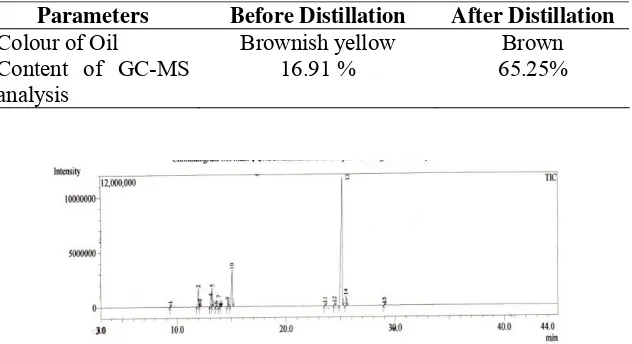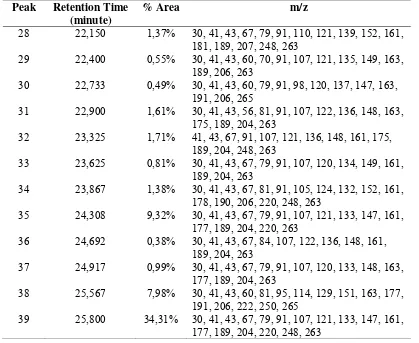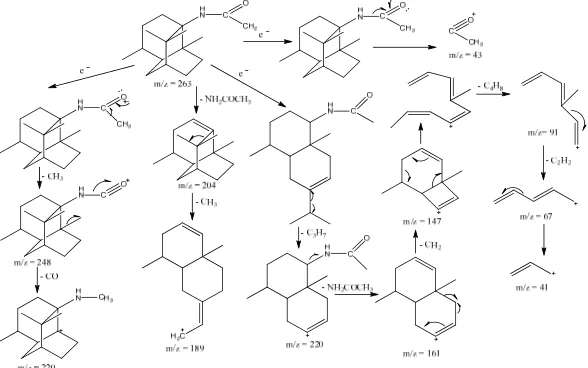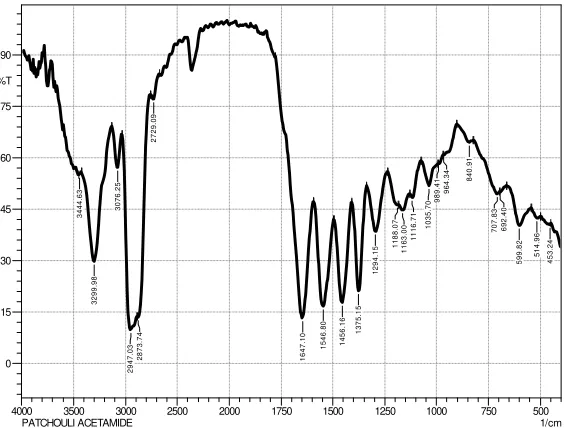The journal homepage www.jpacr.ub.ac.id
ISSN : 2302 ‐ 4690
11
Synthesis Organonitrogen Compounds from Patchouli Alcohol
Through Ritter Reaction with Acetonitrile and Its Toxicity to
Artemia salina
Leach.
Khoirun Nisyak,1 Moh. Farid Rahman,2* dan Sutrisno Sutrisno3
1
Postgraduate Program of Chemistry, Chemistry Department, Brawijaya University, 2Laboratory of Organic
Chemistry, and 3Laboratory of Biochemistry, Faculty of Mathematics and Natural Sciences, Brawijaya
University, Jl. Veteran, Malang 65145, INDONESIA Corresponding email : nisachemist@gmail.com
Received 24 November 2012; Revised 28 January 2013; Accepted 15 February 2013; Published online for 1April 2013
ABSTRACT
Patchouli oil contains a compound with biological activities to human body called the patchouli alcohol that can be further developed in medical field. This research aimed to synthesize organonitrogen compound from patchouli alcohol through Ritter reaction with acetonitrile and evaluate its toxicity towards Artemia salina Leach. Isolation of patchouli alcohol from patchouli oil by means of fractional distillation under reduced pressure. The synthesis of organonitrogen compound was conducted at room temperature with the mol ratio of patchouli alcohol: acetonitrile: sulfuric acid is 1:1.5:4 for 24 hours. The result showed the amount of patchouli alcohol produced from fractional distillation is 65.25%. The main product yielded through Ritter reaction is 36.93% of N-(4,8a,9,9-tetramethyl decahydro-1,6-metanonaftalen-1-il) acetamide. The starting material provided LC50 77.39 ppm, meanwhile the reaction product provided higher toxicity level than that in starting material. It recorded LC50 value 10.39 ppm.
Key word: patchouli oil, patchouli alcohol, synthesis organonitrogen compound, Ritter reaction, toxicity
INTRODUCTION
The journal homepage www.jpacr.ub.ac.id
ISSN : 2302 ‐ 4690
12
antischistosomal, antitumor, and anticonvulsant [9]. Further studies to determine the ability of the synthesis products as a drug candidate can be evaluate through toxicity evaluation using brine shrimp lethality test (BSLT). Wijdharti et al. [12] stated that BSLT method is simple, rapid, inexpensive, and reliable and usually was performed as preliminary stage of the screening potential as anticancer properties before in vitro test in tumor cell.
OH
H H
Figure 1. Patchouli alcohol structure
Structurally, it has rigid ring bonds, including tertiary alcohol group. Reaction to form an organonitrogen compound from alcohol via Ritter reaction is intermediated by a carbocation. Acidic conditions were applied if using starting material such as aliphatic or aromatic nitrile to afford N-alkyl carboxyamide [10]. Carbocation is formed in the transition state. Formation of a stable carbocation is initiated by protonation of substrate with acid, and it is further attacked by nucleophile from nitrogen compound such as acetonitrile.
EXPERIMENTAL SECTION Materials
The chemical used has high purity grade from Merck and used as received (or as mentioned) including Na2SO4 anhydrous, CH3CN, Na2CO3, H2SO4 (95-97%), diethyl eter, and DMSO. The eggs of shrimp Artemia salina was purchased from Biological Laboratory of Islamic State University of Malang, and patchouli alcohol (65.25% purity) was purchased from traditional farmer in Blitar, East Java, Indonesia, and was further purified using fractional distillation under reduced pressure according to procedure reported by Hapsari [8] and Novitasari [9].
Instrumentation
Spectrophotometer FT-IR (Shimadzu FTIR-8400S) and analysis in thin film using NaCl plate, Gas Chromatography-Mass Spectrometer (GCMS-QP2010S Shimadzu).
Procedure for Isolation Patchouli Alcohol from Patchouli Oil
Patchouli oil (75 mL, prior analysis with GC-MS) was dried with Na2SO4 anhydrous, added to a 100 mL-distillation flask and put in a series distillation apparatus with condenser column (60 cm of lenght) and vigreux column (30 cm). The process is then performed by fractional distillation under reduced pressure, the residue was obtained then analyzed with GC-MS and FT-IR
Synthesis of Patchouli Acetamide Compound Through Ritter Reaction
The journal homepage www.jpacr.ub.ac.id
ISSN : 2302 ‐ 4690
13
was added slowly to the mixture, and the mixture was left at room temperature with stirring for 24 hour. The reaction mixture was poured into an erlenmeyer containing 100 mL of cold distilled water, then was added 100 mL of diethyl eter, stirred, and separated using separating funnel. The obtained organic phase was neutralized with sodium carbonate solution, and the organic phase was further dried with Na2SO4 anhydrous, and filtered. The product was evaporated and further concentrated by flowing with nitrogen gas. The synthesized products were analyzed with FT-IR and GC-MS.
Toxicity Test to Artemia salina Leach
Artemia salina eggs were incubated in brine at pH 7-8 (48 h). Series solutions of tested substances at varying concentrations were prepared in DMSO solvent. A determined number of shrimp larvae were introduced into each solution, and were added tested samples, except for control solution without addition sample, and these were left for 24 hour. Number of life larvae was counted under microscope for each each solution used, and to evaluate the toxicity of the sample solution. Tests were carried out in triplicate.
Percent of lethality shrimp Artemia salina was calculated at each concentration by the equation:
where Nt is the number of shrimp larvae that died after incubation for 24 hours and No is the total number of shrimp larvae. LC50 value is then determined by linear regression on analysis of the similarities between the percent of deaths as the y-axis and the concentration as the x axis [13].
RESULT AND DISCUSSION
Isolation Patchouli Alcohol from Patchouli Oil
The yield of patchouli alcohol was obtained from fractional distillation under reduced pressure 65.25 % at 100 mmHg.
Table 1. The data content of patchouli alcohol
Parameters Before Distillation After Distillation
Colour of Oil Brownish yellow Brown
Content of GC-MS analysis
16.91 % 65.25%
The journal homepage www.jpacr.ub.ac.id
ISSN : 2302 ‐ 4690
14 Synthesis Patchouli Acetamide via Ritter Reaction
Product analysis using GC-MS (column Rtx-wax) was afforded chromatogram in Figure 3. Chromatogram compounds synthesized showed a peak that has 14% area of more than 1% and 12 peaks that have M+ = 263 with a retention time sequence, shown in Table 2. Peak with M+ = 263 major expected outcome is a product synthesis, namely N-(4,8a,9,9-tetramethyldecahydro-6,1-1-yl methanonaphtalena) acetamide, or better known as patchouli acetamide.
Figure 3. The chromatogram compound synthesis
Table 2. Data tabulation of mass per charge (m/z) detected from synthesized compounds
Peak Retention Time 178, 190, 206, 220, 248, 263
35 24,308 9,32% 30, 41, 43, 67, 79, 91, 107, 121, 133, 147, 161, 177, 189, 204, 220, 248, 263
The journal homepage www.jpacr.ub.ac.id
ISSN : 2302 ‐ 4690
15
the carbonyl group in patchouli acetamide compound results cleavage α, peak m/z = 263 release CH3 so that produce peak m/z = M+ -15 = 248, then the release CO to form peak of m/z = 220. Cleavage α to C-carbonyl produces a peak m/z = M+ - 220 = 43. Peak m/z = M+ - 59 = 204 is obtained from the release NH2COCH3, then the release CH3 to form the peak m/z = M+ - 74 = 189. Peak m/z = 220 of the release of C3H7 (M+ - 43) then release NH2COCH3 thus forming the peak m/z = 161. Peak m/z = 161 have thus generated the release of C4H8 peak m/z = 91. Peak m/z = 91 release C2H2 respectively so as to produce the peak m/z = 41. Suggested fragmentation pattern for compound patchouli acetamide shown in Figure 6.
Figure 4. The Mass Spectrum Peak 39 with Retention Time 25,8 minutes.
The journal homepage www.jpacr.ub.ac.id
ISSN : 2302 ‐ 4690
16 Figure 6. Plausible mechanism reaction the formation of patchouli acetamide
500
Figure 7. Infrared spectrum of product synthesized
Table 3. Data functional group product synthesis
Wavenumber (cm-1)
Type of vibration
3299, 98 Stretching N-H
2947,03 Stretching C-H
1647,10 Stretching C=O in amide
1546,80 Bending N-H
The journal homepage www.jpacr.ub.ac.id
ISSN : 2302 ‐ 4690
17
Based on FT-IR spectrum of compounds synthesized (patchouli acetamide) and functional groups of data (Table 3), show a strong absorption at wavenumber 3299 cm-1 which is the N-H stretching vibration of secondary amide. It was also supported by absorption at 1647,10 cm-1 for vibration of the amide carbonyl stretching and at 1546,80 cm-1 for N-H bending. This indicates that the presence of secondary amide compounds contained in the compounds synthesized.
Toxicity Test to Artemia salina Leach.
Product synthesis containing patchouli acetamide 36.93% gives higher toxicity. Structure of patchouli acetamide has a lone pair on nitrogen atom, and also carbonyl group has two lone pair on oxygen. These functional groups are predicted able to increase interaction by formation of hydrogen bonds with DNA, and distract the metabolism of A. salina Leach.
Table 4. The calculation result for LC50 from BSLT test
No. Sampel Graph Equation LC50 1 Starting material Y = 0,6462x
It can be concluded that the main products of the synthesis of patchouli alcohol with acetonitrile trough Ritter reaction is N-(4,81,9,9-tetramethyl decahydro-6-1-1-yl methanonaphtalene) acetamide or patchouli acetamide (36.93 % yield). The synthesized compounds have a toxicity level greater than starting material, (10.93 ppm), and it is potential for lead drug compounds.
ACKNOWLEDGMENT
The authors gratefully acknowledge DIKTI for financial support through the Program Kreativitas Mahasiswa 2011 program.
REFERENCES
1. Tsai, Y.C., Hsu, H.C., Yang W.C., Tsai, W.J., Chen, C.C, dan Watanabe, T., J. Fitoterapia, 2006, 326 (6), 224-3.
2. Das, K., Gupta, N.K., Vijayabhaskar, S., dan Manjunath, M., Ind. J. Novel Drug, 2011, 3 (2), 104-111.
3. Wu, H., Li, B., Wang, X., Jin, M,, dan Wang, G., J. Molecules, 2011, 16 (1), 6489-6501, ISSN 1420-3049.
4. Sundaresan, Sigh, S.P., Mishra, A.N., Shasany, A.K., Darokar. M.P., Kalra, A., and Naqvi, A.A., J. Ess. Oil Res., 2009, 21, 220.
The journal homepage www.jpacr.ub.ac.id
ISSN : 2302 ‐ 4690
18
6. Ma’mun and Maryadhi, Jurnal Bul. Littro, 2008, 19 (1), 95-99.
7. Aisyah, Y., Hastuti, P., Sastrohamidjojo, H., and Hidayat, C., Komposisi Kimia dan Sifat Antibakteri Minyak Nilam (Pogostemon cablin), Majalah Farmasi Indonesia, 2008, 19 (3), 151-156.
8. Hapsari, K.W., Reaksi Esterifikasi Patchouli Alkohol dalam Minyak Nilam (Patchouli oil) dengan Asam Asetat Anhidrid Menggunakan Katalis H2SO4 dan H3PO4, Thesis, Department of Chemistry, Faculty of Mathematics and Natural Sciences Brawijaya University, Malang, 2008.
9. Novitasari, R.D., Dehidrasi Patchouli Alkohol dalam Minyak Nilam (Patchouli Oil) Menggunakan Asam Sulfat (H2SO4) dan Asam Fosfat (H3PO4) dengan Variasi Pelarut, Thesis, Department of Chemistry, Faculty of Mathematics and Natural Sciences Brawijaya University, Malang, 2008.
10. Rahman, M.F., Retnowati, R., and Suratmo, Derivatisasi α-Pinena: Sintesis Senyawa Organonitrogen dan Kajian Potensinya Sebagai Kandidat Obat, Faculty of Mathematics and Natural Sciences Brawijaya University, Malang, 2011.
11. Rollas, S., and Küçükgüzel, G., Molecules, 2007, 1910-1939.
12. Czako, B and Kurti, L., Strategic Application of Named Reaction in Organic Synthesis,
2005, Elsevier Academic Press, London.




